
It's about how to be a professional English reader.
- Subject:
- Languages
- Material Type:
- Student Guide
- Author:
- Samih Alkhouly
- Date Added:
- 04/25/2023

It's about how to be a professional English reader.
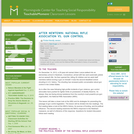
In the wake of the tragic school shooting in Newtown, CT, students learn about and discuss renewed calls for gun control and the National Rifle Association's history of successfully resisting such reforms.

Students use Library of Congress primary sources to examine 19th and 20th century social life in the United States in order to formulate ideas about the American Dream.
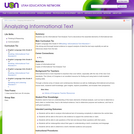
In this lesson students use the Informational Text Analysis Tool to deconstruct the essential elements of informational text. Informational text is more important to teachers than ever before, especially with the rise of the new Core standards. The Library of Congress is an excellent resource for finding and using texts to build students' reading skills.Through a diverse array of classic and contemporary literature as well as challenging informational and primary source texts, students build knowledge, gain insights, explore possibilities, and broaden their perspective.
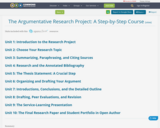
This resource is designed to walk students through the process of completing a research project in any field of study. It covers the earliest stages of brainstorming and discussing, continues through researching and compiling sources; writing, documenting, revising, and polishing a paper; and finally presenting the research topic to a wider audience in a professional manner. The focus is on MLA format, though the course could be modified for other formats.
The first unit is an introduction to the project. It asks students to draw on knowledge of issues affecting their own community and world to help generate discussion that could eventually lead to a research topic.

Students will examine how patriotism comes in many forms through an analysis of the short film "Patriotism and Protest." In the film, experts and Minidoka survivors highlight how the infamous "loyalty questionnaire" during WWII divided the Japanese American community.

Students will examine how news outlets and government propaganda shaped war hysteria and racism against Japanese Americans during WWII. In the short film, "Power of the Press," students will learn about the pre-war racism against Asian Americans and how community allyship can have a profound effect in combating propaganda.

Students will examine how language shapes public perception through an analysis of the short film "Power of Words." In the film, experts highlight the various euphemisms used by the US government to describe the WWII incarceration of Japanese Americans and how the language used to describe this event did not match the reality.

Students will examine the responsibility of citizens through an analysis of the short film "Standing Up for Others." In the film, Japanese Americans draw parallels between their experience during World War II and the experiences of Muslim Americans and asylum-seeking migrant children.
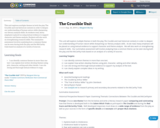
This unit explores multiple themes in both the play The Crucible and real historical contexts in order to deepen our understanding of human nature while sharpening our literary analysis skills. As students read, heavy emphasis is placed on using textual evidence to support character and theme analysis. Students will also work on strengthening research skills. The summative assessment involves analyzing how a common theme can be seen during both the play and the McCarthy trials based on analysis of a variety of sources.
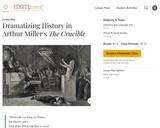
By closely reading historical documents and attempting to interpret them, students consider how Arthur Miller interpreted the facts of the Salem witch trials and how he successfully dramatized them in his play, "The Crucible." As they explore historical materials, such as the biographies of key players (the accused and the accusers) and transcripts of the Salem Witch trials themselves, students will be guided by aesthetic and dramatic concerns: In what ways do historical events lend themselves (or not) to dramatization? What makes a particular dramatization of history effective and memorable?

The 11th grade learning experience consists of 7 mostly month-long units aligned to the Common Core State Standards, with available course material for teachers and students easily accessible online. Over the course of the year there is a steady progression in text complexity levels, sophistication of writing tasks, speaking and listening activities, and increased opportunities for independent and collaborative work. Rubrics and student models accompany many writing assignments.Throughout the 11th grade year, in addition to the Common Read texts that the whole class reads together, students each select an Independent Reading book and engage with peers in group Book Talks. Students move from learning the class rituals and routines and genre features of argument writing in Unit 11.1 to learning about narrative and informational genres in Unit 11.2: The American Short Story. Teacher resources provide additional materials to support each unit.

In this unit, students will take a look at the historical vision of the American Dream as put together by our Founding Fathers. They will be asked: How, if at all, has this dream changed? Is this dream your dream? First students will participate in an American Dream Convention, acting as a particular historical figure arguing for his or her vision of the American Dream, and then they will write an argument laying out and defending their personal view of what the American Dream should be.
ACCOMPLISHMENTS
Students read and annotate closely one of the documents that they feel expresses the American Dream.
Students participate in an American Dream Convention, acting as a particular historical figure arguing his or her vision of the American Dream.
Students write a paper, taking into consideration the different points of view in the documents read, answering the question “What is the American Dream now?”
Students write their own argument describing and defending their vision of what the American Dream should be.
GUIDING QUESTIONS
These questions are a guide to stimulate thinking, discussion, and writing on the themes and ideas in the unit. For complete and thoughtful answers and for meaningful discussions, students must use evidence based on careful reading of the texts.
What has been the historical vision of the American Dream?
What should the American Dream be? (What should we as individuals and as a nation aspire to?)
How would women, former slaves, and other disenfranchised groups living during the time these documents were written respond to them?
BENCHMARK ASSESSMENT: Cold Read
During this unit, on a day of your choosing, we recommend you administer a Cold Read to assess students’ reading comprehension. For this assessment, students read a text they have never seen before and then respond to multiple-choice and constructed-response questions. The assessment is not included in this course materials.

In this 5-day unit, students will explore the topic of cheating. Cheating seems to be ever-present in today’s society. Whether we are talking about athletes being busted for using steroids or students “sharing” answers and plagiarizing on final exams, one thing is clear—there’s a whole lot of cheating going on. In this unit, students will take a look at some contemporary instances of cheating and argue whether under certain situations cheating is not only excusable, but also justifiable.

This unit uses William Shakespeare’s Much Ado About Nothing as a vehicle to help students consider how a person is powerless in the face of rumor and how reputations can alter lives, both for good and for ill. They will consider comedy and what makes us laugh. They will see how the standards of beauty and societal views toward women have changed since the Elizabethan Age and reflect on reasons for those changes. As students consider the play, they will write on the passages that inspire and plague them and on topics relating to one of the themes in the play. Finally, they will bring Shakespeare’s words to life in individual performances and in group scene presentations.
ACCOMPLISHMENTS
Students read Shakespeare’s Much Ado About Nothing .
Students read two Shakespearean sonnets and excerpts from an Elizabethan morality handbook dealing with types of women, and they respond to them from several different perspectives.
For each work of literature, students do some writing. They learn to write a sonnet; create a Prompt Book; complete a Dialectical Journal; and write an analytical essay about a topic relating to a theme in the play.
Students see Shakespeare’s play as it was intended to be seen: in a performance. They memorize 15 or more lines from the play and perform them for the class. Students take part in a short scene as either a director or an actor.
GUIDING QUESTIONS
These questions are a guide to stimulate thinking, discussion, and writing on the themes and ideas in the unit. For complete and thoughtful answers and for meaningful discussions, students must use evidence based on careful reading of the texts.
What are society’s expectations with regard to gender roles?
Does humor transcend time? Do we share the same sense of humor as our ancestors?
How do we judge people?
How important is reputation?
BENCHMARK ASSESSMENT (Cold Read)
During this unit, on a day of your choosing, we recommend you administer a Cold Read to assess students’ reading comprehension. For this assessment, students read a text they have never seen before and then respond to multiple-choice and constructed-response questions. The assessment is not included in this course materials.
CLASSROOM FILMS
The Branagh version of Much Ado About Nothing is available on DVD through Netflix and for streaming through Amazon. Other versions are also available on both sites.

In this unit, students will produce two major pieces of work. The first piece is an argument essay that grapples with one of the core questions of the unit: who are we, and who have we become because of the ways we connect? Students will read, annotate, and discuss several texts together as they consider the issues surrounding this question, and they will also research and annotate independently as they search for more evidence and perspectives to help deepen their ideas. They will also create a museum exhibit as part of a team. The exhibit project will help students identify what's worth preserving about their unique place in history.
PROJECT UNITS
This project unit continues to meet the English Language Arts standards as it also utilizes the learning principles established by the Partnership for 21st Century Skills. It is designed to support deep content knowledge and perseverance through long-term project planning and implementation. In addition, it will help students to recognize, develop, and apply the planning, teamwork, communication, and presentation skills they will use while presenting a final product to their class and/or the greater community. This real-world project-based activity will give students an opportunity to apply the skills they have been learning all year and will guide them to develop the motivation, knowledge, and skills they need in order to be college and career ready.
ACCOMPLISHMENTS
Students write an argument paper where they develop a claim about current culture as it has been influenced by digital connectivity.
Students participate in a group project to create a museum exhibit that captures a unique place, time, and relationship to technology. Students acknowledge the differing perspectives of each group member and use those perspectives to synthesize one cohesive visual argument together.
GUIDING QUESTIONS
These questions are a guide to stimulate thinking, discussion, and writing on the themes and ideas in the unit. For complete and thoughtful answers and for meaningful discussions, students must use evidence based on careful reading of the texts.
What does it mean to be digitally connected?
What are the implications of living in a world where everyone is digitally connected?
How does the availability of instant connectivity shape our relationships?
What does our Internet use reveal about people's needs as humans?
BENCHMARK ASSESSMENT: Cold Read
During this unit, on a day of your choosing, we recommend you administer a Cold Read to assess students’ reading comprehension. For this assessment, students read a text they have never seen before and then respond to multiple-choice and constructed-response questions. The assessment is not included in this course materials.

In this unit, students will explore great works of American literature and consider how writers reflect the time period in which they write. They will write two literary analysis papers and also work in groups to research and develop anthologies of excellent American stories.
ACCOMPLISHMENTS
Students read and analyze stories from several 19th-, 20th-, and 21st-century American authors. After researching a time period, they select stories from that period to create an anthology. The readings enhance their understanding of the short story, increase their exposure to well-known American authors, and allow them to examine the influence of social, cultural, and political context.
Students examine elements of short stories and have an opportunity for close reading of several American short stories. During these close readings, they examine the ways that short story writers attempt to explore the greater truths of the American experience through their literature.
GUIDING QUESTIONS
These questions are a guide to stimulate thinking, discussion, and writing on the themes and ideas in the unit. For complete and thoughtful answers and for meaningful discussions, students must use evidence based on careful reading of the texts.
If you were to write a short story about this decade, what issues might you focus on?
What defines a short story? Just length?
To what extent do these stories reflect the era or decade in which they were written?
To what extent are the themes they address universal?
CLASSROOM FILMS
History.com has short videos on the Vietnam War (“Vietnam” and “A Soldier's Story”).

The 12th grade learning experience consists of 7 mostly month-long units aligned to the Common Core State Standards, with available course material for teachers and students easily accessible online. Over the course of the year there is a steady progression in text complexity levels, sophistication of writing tasks, speaking and listening activities, and increased opportunities for independent and collaborative work. Rubrics and student models accompany many writing assignments.Throughout the 12th grade year, in addition to the Common Read texts that the whole class reads together, students each select an Independent Reading book and engage with peers in group Book Talks. Language study is embedded in every 12th grade unit as students use annotation to closely review aspects of each text. Teacher resources provide additional materials to support each unit.

Who decides who among us is civilized? What rules should govern immigration into the United States? Whom should we let in? Keep out? What should we do about political refugees or children without papers? What if they would be a drain on our economy?
ACCOMPLISHMENTS
Students read William Shakespeare’s play The Tempest and write a short argument about who in the play is truly civilized.
Students participate in a mock trial in which they argue for or against granting asylum to a teenage refugee, and then they write arguments in favor of granting asylum to one refugee and against granting it to another.
Students read an Independent Reading text and write an informational essay about a global issue and how that relates to their book.
GUIDING QUESTIONS
These questions are a guide to stimulate thinking, discussion, and writing on the themes and ideas in the unit. For complete and thoughtful answers and for meaningful discussions, students must use evidence based on careful reading of the texts.
What role do national identity, custom, religion, and other locally held beliefs play in a world increasingly characterized by globalization?
How does Shakespeare’s view of human rights compare with that in the Universal Declaration of Human Rights?
Who is civilized? Who decides what civilization is or how it’s defined?
How do we behave toward and acknowledge those whose culture is different from our own?